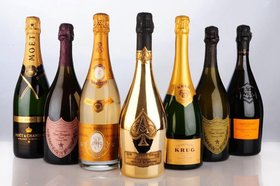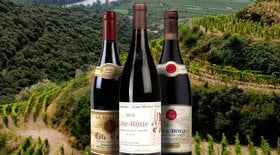Red Wine vs White Wine (Differences, Which is Healthier?)
Red wine vs white wine - what’s the difference?
Which of them is really healthier - red wine or white wine? How do they taste, and what foods should you pair them with?
Red wine is loved for its rich, dark fruit flavors and tannins, while white wine is known to be more refreshing, fruity, and citrusy. In terms of health benefits, red wine definitely gets more praise and attention.
In this article, we’ll look at what sets them apart — how they’re made, their health benefits, their different styles and taste profiles. We’ll also show you an easy way to buy the best, authentic red and white wines — for drinking right away and storing in your wine cellar for the long term.
Further reading
- Discover the Best Wine Brands to collect.
- If you need help picking a wine for a celebration, try Viognier.
- Also, explore Moet Champagne, perfect for your next event!
Red Wine vs White Wine: How Are They Made?

Grapes produce a clear juice, regardless of their skin color. So how do red and white wines get their unique color and taste profiles dividing red wine drinkers and white wine drinkers all over the world?
Here’s how.
Red wine and white wine grapes
In general, red wine is made from red or black grapes like Pinot Noir, Cabernet Sauvignon or Malbec. Most white wines come from white grapes like Chardonnay, Pinot Grigio or Riesling.
Different grape parts used in making red wine and white wine
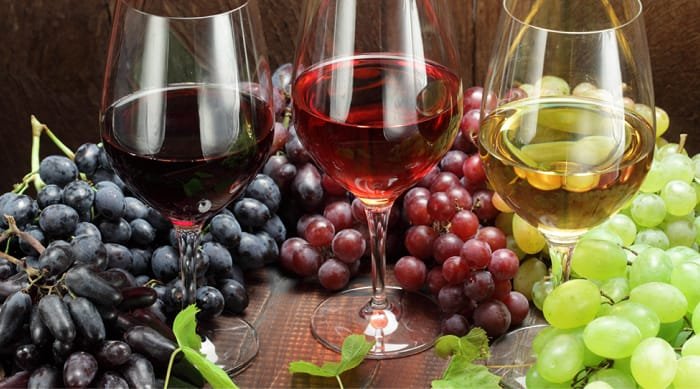
For red wine, the grape is crushed with the skin. Yeast that’s naturally present on the grape skin starts fermentation. Some winemakers add yeast to the grape juice to initiate this process as well.
As the red wine ferments, color, flavors and tannins are leached from the skin and seeds into the juice. This is called “maceration.” Longer maceration periods tend to produce deeper reds with stronger flavors.
However, for white wine, the grape skin and seeds are removed before the fermentation process. Yeast is then added to the juice to start fermentation.
But, can you make white wine from red grapes?
Yes. White wine can be made from red grapes as well. The secret lies in using the grape juice and fermenting it without the grape skin. This style is called “blanc de noir,” and a well-known example is Champagne made from Pinot Noir grapes.
Also, have you heard of Orange Wine?
Also called “skin-contact white wine” or “amber wine,” it’s made with a rare technique where white grapes ferment together with the grape skin and seeds. The resulting wine tastes more like red wine and has tannin.
Different winemaking methods used in producing red wine and white wine

White wine is typically aged in stainless steel vats. This retains the flowery and fruity flavor as there’s minimal exposure to oxygen.
Most reds are aged in oak barrels, which leads to controlled oxidation - they’re called oaked wines. Oak aging causes the wine to gain a rich, smooth, nutty flavor and evolve its fruity notes to more complex aromas. And it’ll pick up the oak taste of the barrel that it’s aged in.
There are always exceptions. Some reds (unoaked wines) meant for early drinking are aged in stainless steel, as not all red wines are suited to oak aging. Also, a neutral white wine like Chardonnay is often aged in oak to give it more complexity.
Now, let’s look at the health aspect of red and white wines.
Red Wine vs White Wine, Which is Healthier?
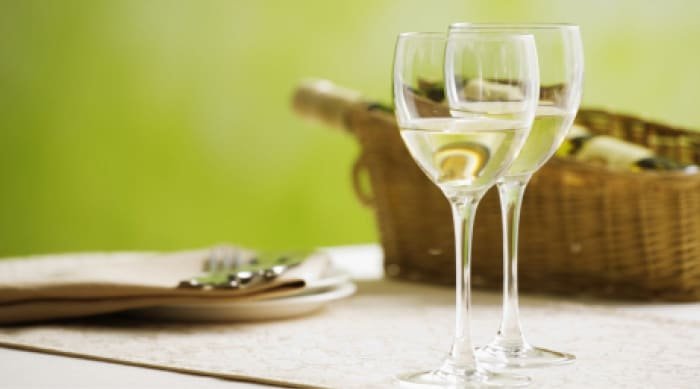
Red and white wine can both be good for your health, but they have different health benefits - thanks to the different processing stages that the wines go through.
Nutritional content of red and white wines
How much calories and sugar does wine contain?
In wine, alcohol is the primary source of calories, so you can’t truly standardize the number of calories in one glass. A sweet, low alcohol wine like a Moscato d’Asti will have fewer calories than a dry, but high alcohol wine like Sauvignon Blanc.
Carbohydrates come from the sugar content of the wine. So a sweet wine will have more carbohydrates than a dry wine. For example, a 5oz glass of sweet Riesling will have around 5.5g of carbohydrates compared to the 3.8g in a 5oz glass of dry Syrah.
Here’s a quick look at what else is present in a typical 5oz glass of wine:
- Magnesium: 4% DV - helps regulate muscle and nerve function.
- Potassium: 4% DV - keeps your kidney functioning.
- Calcium: 1% DV - helps build bones.
- Vitamin B6: 4% DV - used by enzymes reaction for metabolism.
- Riboflavin: 2% DV - an antioxidant that helps deliver oxygen to the body.
Let’s look at the benefits of red and white wine next.
Health benefits of red vs white wine
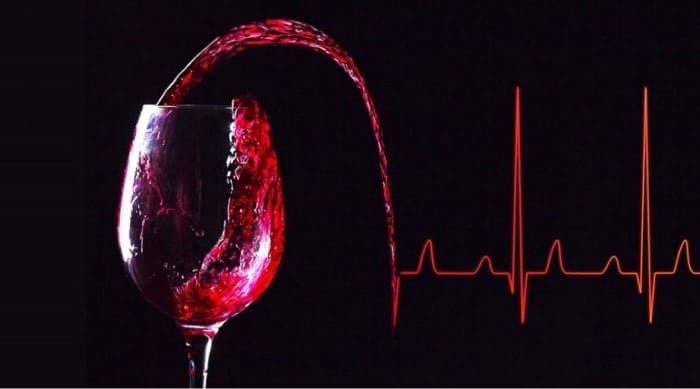
Polyphenols, which are antioxidants, in red wine come from the grape skin.
Studies suggest that polyphenols have several positive effects, including:
- The polyphenol resveratrol can help improve good cholesterol levels while reducing bad cholesterol.
- Helps protect the lining of blood vessels and lessens the risk of blood clots that can lead to heart disease.
- Polyphenols are antioxidants, which help prevent premature aging.
- Can help slow down mental decline due to aging.
White wine is made without the skin, so does it lose all the health benefits?
Not necessarily. White wines have polyphenols too, just to a much lesser degree than red wine. Some studies suggest these benefits:
- A phenol called caffeic acid in white wine can reduce heart and kidney problems.
- Aged white wine can help improve heart health by repairing the endothelial cells lining blood vessels.
White wine also tends to have lower alcohol and calories than red wine.
If you’re hypersensitive (and some people are) to that glass of red wine, you can still drink white wine and reap some health benefits.
So which red and white wines are the healthiest?
Red wine: Pinot Noir, Merlot, Cabernet Sauvignon
White wine: Pinot Grigio, Chardonnay, Sauvignon Blanc
What are the Drawbacks of Drinking Wine?
Too much alcohol is never good for anyone. You don’t want the risks of alcohol consumption to outweigh the benefits. Some of the drawbacks of wine drinking:
- It can mess up your weight loss efforts with additional calories and alter your metabolic rate.
- It can disrupt your sleep cycle.
- It can increase the risk of a stroke with too much consumption.
It can increase stress levels.
Drinking wine can be good for you in some ways, but in moderation.
How do you define moderation?
That’s two drinks a day (of 5oz glass of wine).
If you’re looking to cut down your sugar intake, you can consider dry white or red wine, as these tend to contain less residual sugar from fermentation.
Red Wine vs White Wine: The Wine Styles
Red wine and white wine come in a large variety of styles and can be broadly categorized based on structure. By structure, we mean the acidity, tannin, body, sweetness, and alcohol.
Take a look at each type of wine.
Red Wine Styles
The choice of red wine is endless, but it can generally fall into these three styles.
1. Full-bodied reds
Full-bodied red wines are produced from grapes with thicker skin. These wines undergo a longer maceration period, which results in a wine with more tannin and higher alcohol content.
Shiraz and Syrah

Shiraz is a bold, spicy, dry red wine that offers flavors of rich fruits like plum and blackberry, and sometimes even smoke, herbs, and bacon. Known as Syrah in France, the most complex version of this expressive wine comes from northern Rhone (Hermitage and Côte-Rôtie, for example.)
Some of the best Shiraz (Syrah) wines you should try are:
- 2016 Domaine Rene Rostaing Cote Rotie Cote Brune (France)
- 2015 E. Guigal Cote Rotie La Landonne (France)
- Penfolds Bin 170 Kalimna Vineyard Shiraz (Australia)
Read more about the French wine regions and some of the best French wines you should try.
Cabernet Sauvignon
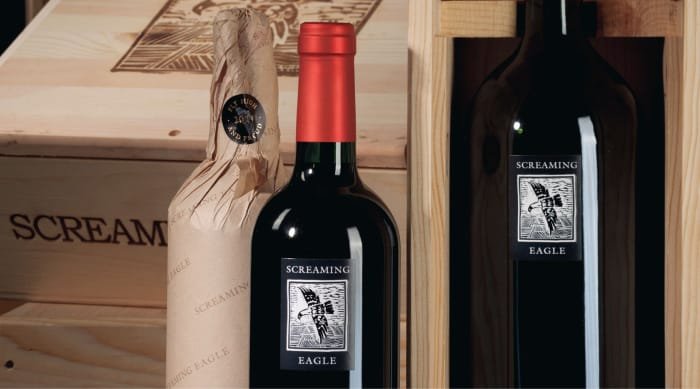
2006 Screaming Eagle Cabernet Sauvignon, Napa Valley (US)
This is probably one of the most common wines you’ll find and is the most planted wine grape in the world. It’s a deep red, dry wine with flavors that range from fruity to smoky oak. You’ll get notes of currants, cherries, dark berries, vanilla and cedar too.
Although Bordeaux is the original home of the Cabernet Sauvignon, where it finds some of its best expression, you won’t find many of these single-varietals there. The grape is usually blended with other grapes to make “Bordeaux Blends.”
Don’t miss these Cabernet Sauvignon wines:
- 2006 Screaming Eagle Cabernet Sauvignon, Napa Valley (US)
- 2012 Abreu Vineyard Madrona Ranch Cabernet Sauvignon (US)
- Château Lafite Rothschild Premier Cru Classes, Pauillac (Bordeaux Blend)
Cabernet Franc
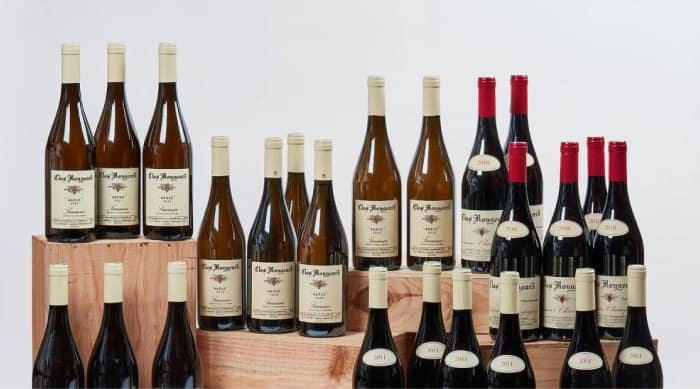
Clos Rougeard Saumur-Champigny Les Poyeux (France)
Cabernet Franc is more tannic and earthy compared to Cabernet Sauvignon. You’ll find notes of blueberry and violets, black olive, coffee and earth.
Cabernet Franc wines to try:
- 2011 Marchesi Antinori Tenuta Guado al Tasso Matarocchio Bolgheri Superiore (Italy)
- 2010 Clos Rougeard Saumur-Champigny Les Poyeux (France)
- 2011 Tenuta Argentiera 'Lavinia Maria' Bolgheri (Italy)
2. Medium-bodied reds
Medium-bodied reds have less tannin than the full-bodied reds, with moderate acidity and a fruity aroma.
Merlot

Petrus Pomerol (France)
If you’re a white wine drinker looking to try a red wine, Merlot is an easy drink to start with! It’s low on acidity and tannins with juicy berry flavors like raspberry, blackberry and even chocolate!
Some of the best Merlot wines are:
- 2015 Petrus Pomerol (France)
- 2015 Masseto Toscana IGT (Italy)
- 2013 Kapcsandy Family Winery State Lane Vineyard Roberta's Reserve (US)
Barbera
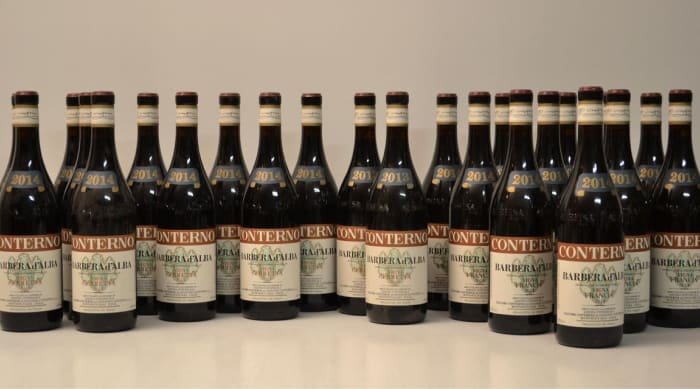
2013 Giacomo Conterno Vigna Francia Barbera d'Alba
Barbera is a wine grape variety grown in several Italian wine regions like Piedmont, Campania and even Sicily. Most young Barbera wines taste of bright cherry and softer tannins. Aging turns this into denser, sour-cherry notes.
The Barbera wines you should try out:
- 2015 Roberto Voerzio Riserva Pozzo dell'Annunziata Barbera d'Alba (Italy)
- 2011 Giacomo Bologna Braida Ai Suma (Italy)
- 2013 Giacomo Conterno Vigna Francia Barbera d'Alba (Italy)
3. Light-bodied reds
These are the lightest of the red wines, made from red wine grapes with thinner skin and is the least tannic of the three styles.
Pinot Noir

2012 Marcassin 'Marcassin Vineyard' Pinot Noir (US)
Pinot Noir is delicate, light and silky, usually featuring floral notes with raspberry and clove. Aging allows smokey and vanilla flavors to emerge. Burgundy is one of the principal Pinot Noir producing regions.
Some excellent Pinot Noir to try:
- 2014 Domaine Armand Rousseau Pere et Fils Chambertin Clos-de-Beze Grand Cru (France)
- 2010 Joseph Drouhin Musigny Grand Cru (France)
- 2012 Marcassin 'Marcassin Vineyard' Pinot Noir (US)
Gamay
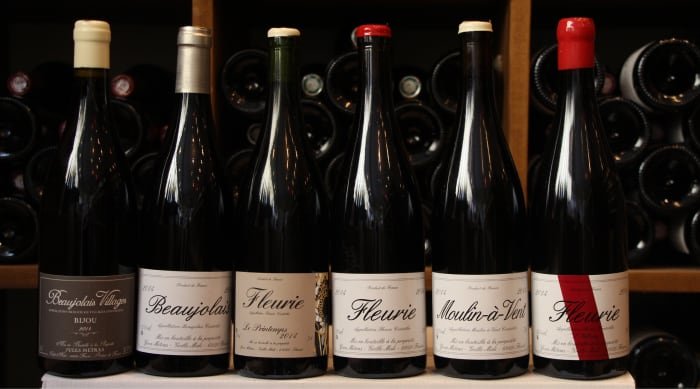
Chateau des Bachelards Comtesse de Vazeilles Fleurie Le Clos
Gamay produces early drinking wines and is most commonly grown in Beaujolais and the Loire Valley in France. The wines are light, with fruit-forward aromas and flavors.
Gamay wines to taste:
- 2016 Chateau des Bachelards Comtesse de Vazeilles Fleurie Le Clos (France)
- 2017 Yvon Metras Fleurie (France)
- 2017 Domaine Louis Claude Desvignes Morgon Javernieres Les Impenitents (France)
White Wine Styles
The white wines can be divided into three categories.
1. Full-bodied whites
Full-bodied white wine typically goes through malolactic fermentation then aging in oak barrels.
Chardonnay
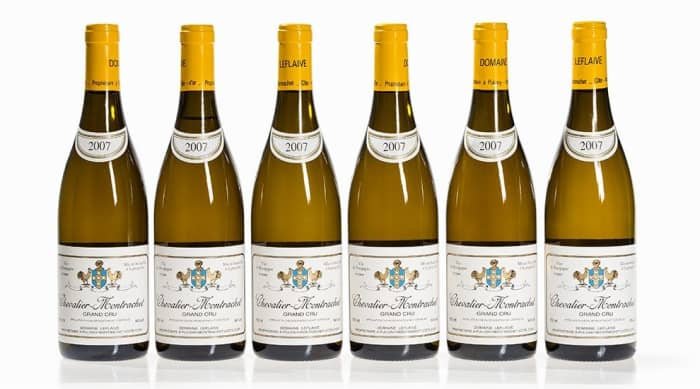
Domaine Leflaive Chevalier-Montrachet Grand Cru
Chardonnay originated in Burgundy in France but is now grown in almost all wine regions of the world.
The taste profile is incredibly different too. Burgundy Chardonnay (also known as White Burgundy) tends to have a crisp, complex fruit flavor with an earthy minerality. California Chardonnay is richer, creamier with ripe fruity and vanilla flavors, and so on.
Some Chardonnay for the white wine lover:
- 2013 Domaine Leflaive Chevalier-Montrachet Grand Cru (France)
- 2012 Peter Michael 'Point Rouge' Chardonnay (US)
- 2017 Rene et Vincent Dauvissat-Camus Les Preuses (France)
Read more about Montrachet wines in this article.
Ribolla Gialla

2010 Gravner Ribolla Venezia Giulia IGT (Italy)
Ribolla is grown mostly in the province of Friuli in Italy but can also be found in Slovenia, where it’s known as Rebula. The wines are faintly floral with notes of citrus, apple and peach.
The Ribolla Gialla wines to taste:
- 2010 Gravner Ribolla Venezia Giulia IGT (Italy)
- 2017 Miani Pettarin Ribolla Gialla Colli Orientali del Friuli (Italy)
- 2013 Ferdinand 'Epoca' Rebula - Ribolla Gialla (Slovenia)
2. Light-bodied whites
Light-bodied white wines are crisp, dry and highly drinkable at an early age.
Sauvignon Blanc
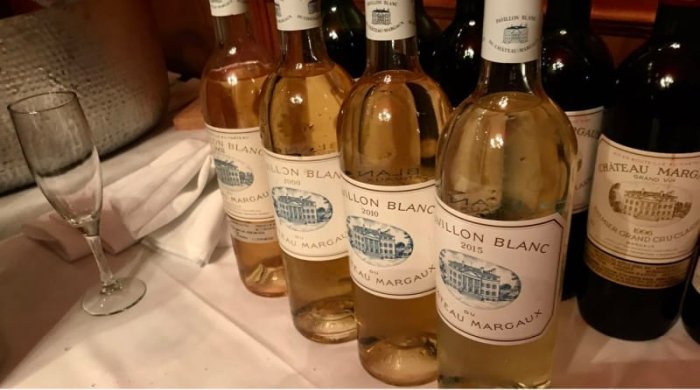
2015 Pavillon Blanc du Chateau Margaux (France)
Sauvignon Blanc is found mostly in the Bordeaux and Loire Valley. It’s quite different from other white wines because of its green and herbaceous flavor profile, like gooseberry, jalapeno, bell pepper and even grass.
Don’t miss these Sauvignon Blanc:
- 2015 Pavillon Blanc du (France)
- 2013 Weingut Sattlerhof Sauvignon Blanc Trockenbeerenauslese (Austria)
- 2010 Didier Dagueneau Sancerre 'Le Mont Damne' (France)
Pinot Gris

2015 Albert Boxler Pinot Gris Sommerberg (France)
Pinot Gris in France (known as Pinot Grigio in Italy) is a pinkish-grey grape related to Pinot Noir. However, the wine styles of Pinot Gris and Pinot Grigio should not be confused as they are rather different. Pinot Gris is richer and spicier compared to the light and crisp Pinot Grigio.
Some fine Pinot Gris wines are:
- 2010 Domaine Zind-Humbrecht Pinot Gris Clos Jebsal Selection de Grains Nobles Trie Speciale (France)
- 2015 Albert Boxler Sommerberg (France)
- 2016 Domaine Weinbach Pinot Gris Clos des Capucins Cuvee Sainte Catherine (France)
3. Aromatic whites
Aromatic white wines are floral and fruity and dessert wine drinkers will love its sweetness.
Moscato (Muscat)

Groot Constantia Grand Constance Muscat
Muscat (known as Moscato in Italy and Muscatel in Spain) is one of the oldest grape families. There’s no true “Muscat,” though there are many versions. Moscato Bianco is the oldest of the Muscats and is used to produce the sweet, low alcohol Moscato d’Asti.
Delicious Moscato for you to try:
- 2014 Compania de Vinos Telmo Rodriguez 'Molino Real' Montain Wine (Spain)
- 2017 Paolo Saracco DOCG (Italy)
- 2016 Groot Constantia Grand Constance Muscat (South Africa)
Riesling

Egon Muller 'Le Gallais' Wiltinger Braune Kupp Riesling Auslese
Riesling is an aromatic grape from the Rhine region of Germany, known for strong floral aromas and crispness due to high acidity. This is a low alcohol wine that offers the flavor of apples, apricots and peaches.
Some lovely Riesling wines:
- 2015 Peter Jakob Kuhn Oestricher Lenchen Riesling Trockenbeerenauslese (Germany)
- 2011 F.X. Pichler 'Unendlich' Riesling Smaragd (Austria)
- 2016 Egon Muller 'Le Gallais' Wiltinger Braune Kupp Riesling Auslese (Germany)
What is Rosé Wine?
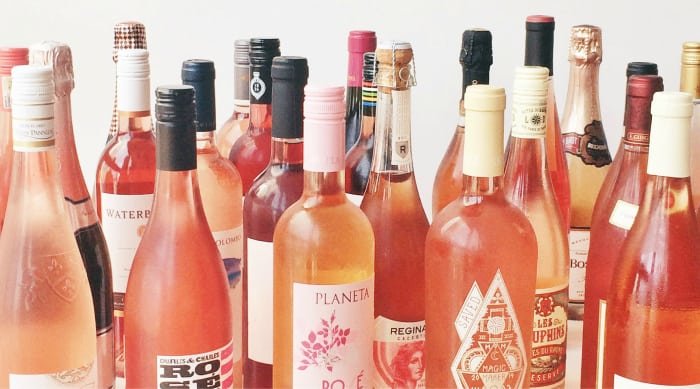
Rose wines are made when red grape skin comes in contact with the wine for only a short time. There are three ways to make rose wine (which also gives it its color):
- Maceration: Red grapes go through a shorter maceration period. The grape skin stays in contact with the grape juice for just a few hours. Pink Zinfandel is a good example of this.
- Saignée or “Bled” technique: When making red wine, some juice is bled off within the first few hours to make a rosé.
- Blending:They’re also made by blending red and white wine.
Other Common Wine Styles
Here are some other common wine styles you might come across.
Table wine
Table wines or light wines (in Europe) are typically still, of moderate quality, and lower alcohol content. In the US, alcohol shouldn’t be higher than 14%, and in Europe, it should be 8.5%-14%.
Dessert wine
Dessert wine is a fortified wine with more than 14% alcohol, as the winemaker adds alcohol during processing. Sherry from Spain and Port from Portugal are popular examples.
Sparkling wine
Wine with bubbles are generally called sparkling wines. The bubbles come when carbon dioxide gets trapped inside when the wine undergoes a secondary fermentation in the bottle. It’s called Champagne, if made in the Champagne region in France (like the famous Dom Perignon!). It is known as a sparkling wine in the US, Cava in Spain, Prosecco in Italy, and so on.
Red Wine vs White Wine: Taste Profile

Red wine and white wine generally have very different taste profiles. Here’s what you can expect.
Red wines have more tannins than whites and have the flavor of berries, from strawberries, raspberries to the darker blackberries and plums.
Reds with higher tannin levels age better, and with aging, the resulting wine can become incredibly complex.
White wines tend towards crisp, citrusy flavors with floral aromas. The richer whites will be nuttier and sometimes buttery.
You won’t find much tannin in white wine, but the acidity will be more pronounced. Acidity is what gives white wine it’s crisp, tart character.
Red Wine vs White Wine: Food Pairings
You have your wine glass. What color of wine do you pour with your meal? Should it be a dry red or an aromatic white?
Red wine food pairing

Grab your red wine glass and pair the following foods with them:
- Pinot Noir: Pairs well with mushrooms and truffles.
- Barolo: Matches with fatty meats like lamb.
- Cabernet Sauvignon: You can’t go wrong pairing this with a juicy steak.
- Shiraz:This bold red sits well with BBQ sauces.
White wine food pairing
And to match your white wine glass:
- Chardonnay: Pairs with chicken and fatty fish like salmon.
- Sauvignon Blanc: Works well with oysters, cheese and green vegetables.
- Pinot Grigio: Match this with light seafood dishes.
- Moscato d’Asti: Pair this with your fruity desserts.
When in doubt, you could stick to the standard “red with red meat, white with white meat,” though there are exceptions to every rule. Learning the exceptions is part of the fun of drinking wine!
That said, how do you buy authentic red and white wines - for drinking or for adding to your wine collection?
You could scour the entire universe of reds and whites, buy bottles from boutique wine stores or online. But, you need to check if your bottle is a genuine one. You also have to store them impeccably well if you’ve to protect its taste and health benefits in the long run! With so many options, it’s best to come to a platform like Vinovest.
Here’s the easiest way out:
Buy the Best Red and White Wines Through Vinovest
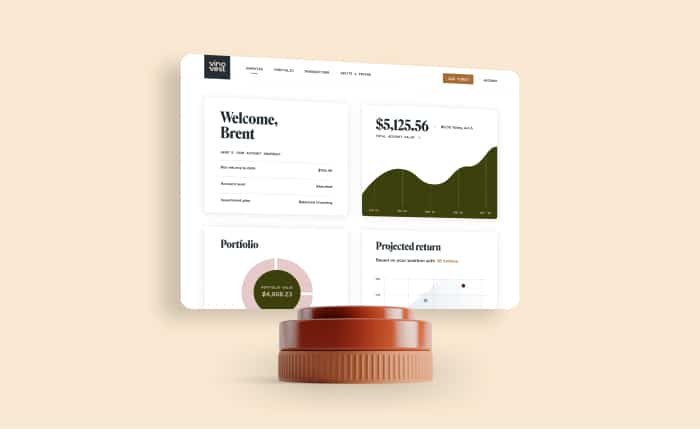
Vinovest is an Artificial Intelligence-based online wine investment platform that helps you buy and sell red and white wines, and any other wine from anywhere in the world, both for drinking and investing.
Vinovest’s expert team of Sommeliers help you in choosing authentic wines at the best wholesale prices you can get.
Not only that, Vinovest will store your wines under optimal conditions of light, temperature, humidity, and vibration so that your wines never get spoilt, and are allowed to develop their taste and complexities beautifully.
They also insure your wines and deliver them to you, whenever you want to take a sip!
Better still - in case you want to sell your wines, Vinovest will do it for you, and deliver your bottle to the buyer.
Conclusion
Red wine vs white wine is a thoroughly enjoyable debate in terms of their taste, styles, and health benefits!
Discovering the best red and white wines could set you off on an interesting, yet complex adventure in the world of wines. Signing up on a wine investing platform like Vinovest could be the best way to navigate this with ease.

